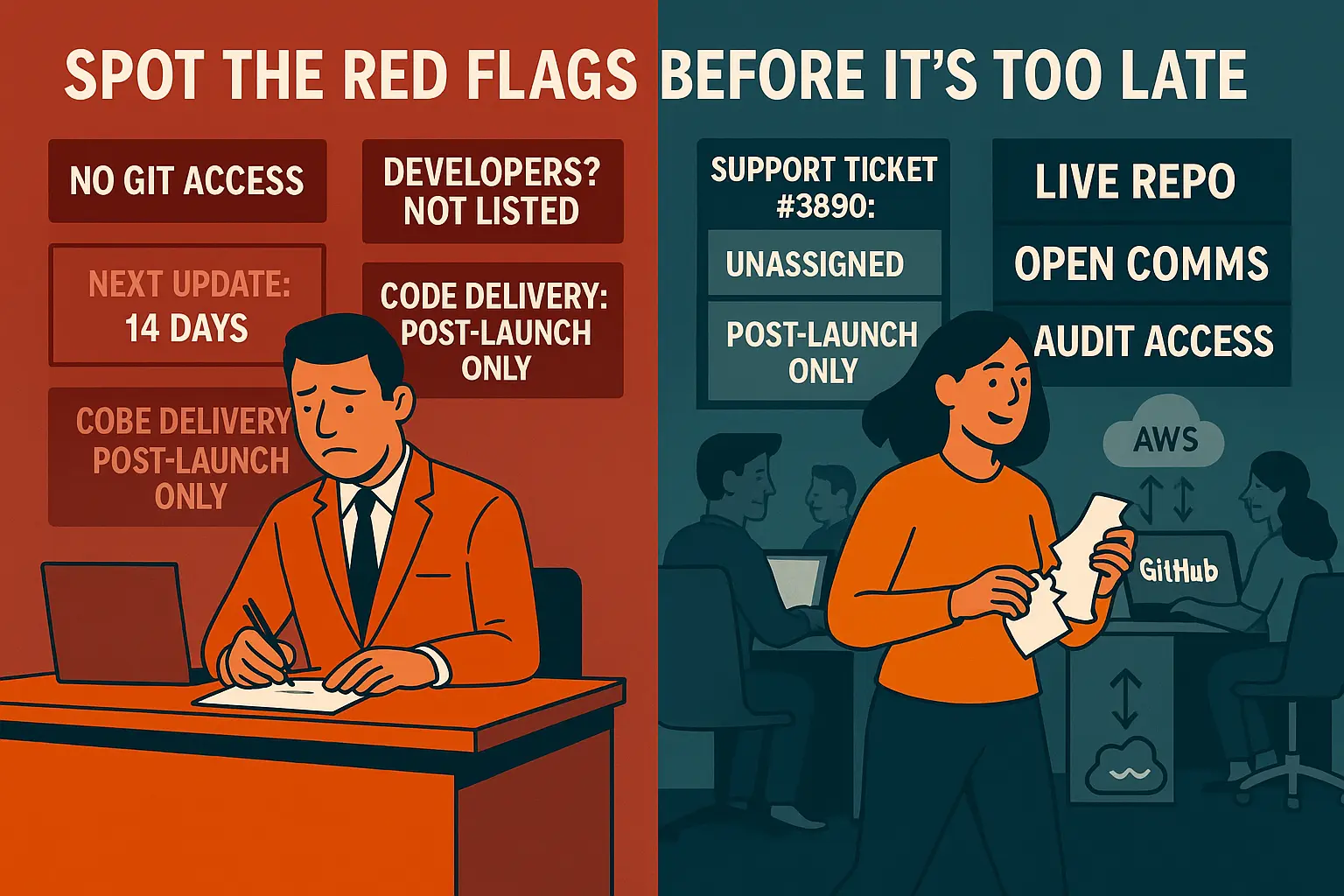“Before Builder.ai went silent, there were signs.”
- Clients were frustrated.
- Support was slow.
- The code was inaccessible.
- Developers were anonymous.
But no one thought the entire platform would collapse until it did.
If you’re buying software services in 2025, you can’t just look at demos. You must identify the red flags and protect your roadmap from becoming the next cautionary tale.
Red Flag #1: You Don’t Know Who’s Building Your Product
When your “team” is a form on a dashboard, you don’t have a team. You have a vendor wall.
Real teams are introduced. You meet them. You’re onboard them. You manage outcomes.
If your devs are invisible, your project is vulnerable.
Red Flag #2: You Can’t Access the Codebase
You’d be shocked how many platforms “own” the code they build.
Or store it somewhere you can’t touch.
If you can’t see the repo, check the commits, or download your assets, you don’t own your product.
Code access should be yours from day one.
Red Flag #3: No Git, No Infra, No Exit Plan
Builder.ai clients learned this the hard way:
Your product’s value can’t depend on a platform’s stability. It has to live in a place you always control.
Red Flag #4: No Developer Accountability
When bugs happen or timelines slip, who do you talk to?
If it’s just a “support ticket” or “assigned queue,” you’re not managing a team. You’re outsourcing trust, and hoping it doesn’t break.
You deserve a model where developers report to you, not disappear behind a ticket ID.
Red Flag #5: AI-Led Pitch, Human-Less Delivery
Builder.ai was the poster child of AI buzzwords.
“AI builds your app. No developers needed.”
But when things broke, AI didn’t fix it. Because AI can’t make strategic decisions, respond to nuance, or rewrite architecture.
Don’t be blinded by buzz. Ask about escalation paths, code ownership, and team continuity.
Red Flag #6: Locked Timelines and Templates
True software development is iterative.
If your vendor only offers rigid timelines, templated features, and limited change requests, you’re not building a product. You’re buying a one-size-fits-none process.
Avoid vendors who treat your roadmap like a menu.
Red Flag #7: You Can’t Leave Easily
Try this exercise: Imagine your vendor shuts down tomorrow.
- Do you have the code?
- Can another team take over?
- Is your infra portable?
- Can you keep shipping?
If the answer is “no,” you’re already in a risky position, you just don’t know it yet.
The HireDeveloper.dev Approach: Built for Buyer Control
Here’s how we eliminate every red flag above:
- You own the code and infrastructure.
- You know every developer.
- You get Git and staging access from day one.
- You can escalate, iterate, and exit at any time.
- You decide the stack, tools, and roadmap, we support it.
We don’t trap clients. We build trust by giving you total control over your team and product.
A Founder’s Story: Spotting the Red Flags in Time
A founder came to us after almost signing a multi-year build contract with a closed platform. They asked: “Do I get code access during the build?”
The answer was: “No, it’s transferred post-launch.”
Red flag. They walked away.
We built their MVP in 7 weeks, on their Git, with their team, and their rules.
If You’re Seeing the Red Flags, It’s Not Too Late
Switch to a model where you own your product, your process, and your peace of mind. At HireDeveloper.Dev, we empower you with full control over your codebase, infrastructure, and development team, no lock-ins, no surprises.
Talk to us about safer software delivery. Book your free consultation call now or contact us at +91-8103094848 to get started.
Related Resources:
- What Happened to Builder.ai? A Breakdown for Startup Founders
- How Builder.AI’s Collapse Shook the Startup World?
- How to React When Your Development Partner Fails Overnight?
- The 5 Stages of Vendor Grief and How to Get Unstuck
- Builder.ai’s Fall: Lessons for Product Owners and CTOs
- Builder.ai Migration Checklist: Save Your Code, Your Time, Your Product
- You Don’t Need to Start Over How to Transfer Your Project Safely
- From Panic to Progress, Real Strategies to Move on from Builder.ai
- Why Moving Fast Now After Builder.ai’s Collapse Will Save You Months Later
- How HireDeveloper.Dev Helps Builder.ai Clients Rebuild with Confidence
- Builder.ai vs. Human-Led Dev Teams: What We’ve Learned
- No More Black Boxes: The Power of Developer Transparency
- AI Was the Hype: Human Execution Is the Reality
- In Crisis, Founders Need More Than Just Tech: They Need Trust
- Why Owning Your Codebase Is Non-Negotiable in 2025
- From Locked to Liberated: How We Helped Former Builder.ai Clients Reclaim Control
- The Myth of One-Click Apps: Why Custom Always Wins in the Long Run
- What Every Investor Wants to Know: Technical Due Diligence After Builder.ai
- From Recovery to Resilience: A Blueprint for Building Post-Builder.ai

